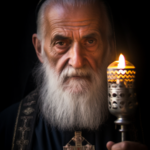St. George
St. George
When They Lived
St. George is believed to have lived during the late 3rd century to early 4th century, around 270–303 AD. The exact dates are uncertain due to the historical nature of the figure.
Where They Lived
St. George’s traditional association is with the city of Lydda in Roman Palestine, which is modern-day Lod in Israel. However, his veneration spread throughout the Christian world.
Notable World Events During Their Time
- Diocletian’s Persecution: St. George lived during a time when the Roman Empire, under Emperor Diocletian, launched one of the most severe persecutions against Christians, known as the Diocletianic Persecution (303–311 AD).
- Battle of Milvian Bridge: In 312 AD, Constantine the Great, who later converted to Christianity, won a crucial battle at the Milvian Bridge, which marked a turning point in the history of the Roman Empire and had significant implications for the spread of Christianity.
- Edict of Milan: In 313 AD, the Edict of Milan, issued by Constantine and his co-emperor Licinius, granted religious tolerance to all religions within the Roman Empire, effectively ending the persecution of Christians.
- Development of Early Christian Doctrine: During St. George’s time, significant theological debates and the development of early Christian doctrine were taking place, laying the foundation for the future structure of the Christian Church.
Their Patronage
St. George is the legendary dragon-slaying saint and is widely known as the patron saint of several things, including:
- Soldiers: St. George’s legendary courage and chivalry have made him a symbol of bravery and protection for soldiers.
- England: St. George is the patron saint of England, and his emblem, a red cross on a white background (St. George’s Cross), is a prominent symbol in English culture.
- Scouts: Many scouting organizations around the world have adopted St. George as their patron saint, emphasizing the values of honor and service.
- Farmers and Agricultural Workers: In some regions, St. George’s feast day is associated with the beginning of the agricultural season.
The Saint of Legends and Stories
One of the objects of a vast amount of imagination is St. George. The life of this saint is surrounded by various stories and legends. The Catholic Church adheres to this saint’s memory and the inspiration and lessons he brings.
St. George was born around the 3rd century in Cappadocia, modern-day Turkey, to a Cappadocian father and a Palestinian mother of noble rank. After the death of his father, he moved to Palestine with his mother. Popular legends say that he was a knight. However, it is more likely that he was an officer in the Roman army. By his late 20s, he had become a Tribunus and served as an imperial guard for the Emperor at Nicomedia.
A Brave Soldier of Christ
During George’s service in the Roman army, Diocletian became emperor. In 303, Emperor Diocletian, who hated Christians, issued a decree that every Christian the army passed would be arrested. He also ordered that every other soldier offer a sacrifice to the Roman gods. George, who was a faithful Christian then, refused to obey the emperor’s order. He even told Diocletian about his firm conviction. The emperor was enraged; however, he greatly valued his friendship with George’s father.
In an effort to save George, the Emperor Diocletian tried to convert him and persuade him to believe in the Roman gods. He also offered him money, land, and slaves in exchange for offering a sacrifice to the Roman gods. These and many other offers were refused by George.
After exhausting all possible options, the Emperor ordered the execution of George. George gave his money to the poor in view of his death. He was sent to undergo several sessions of cruel torture. He was lacerated on a wheel of swords and required resuscitation three times. Despite the painful torture, George did not turn from God. Finally, after many tortures he endured, George was decapitated before Nicomedia’s outer wall.
Another Story of His Martyrdom
Another account of the martyrdom of St. George is in Eusebius´ Ecclesiastical History, which relates that when the emperor Diocletian issued an edict “to tear down the churches to the foundations and to destroy the Sacred Scriptures by fire… a certain man, of no mean origin, but highly esteemed for his temporal dignities, stimulated by a divine zeal, and excited by an ardent faith, took it as it was openly placed and posted up for public inspection, and tore it to shreds as a most profane and wicked act.” This act of intransigence and holy audacity enraged the emperor, who had the man tortured and killed. This man “of no mean origin”, i.e., of nobility, has been identified by more than one ancient source, including Eusebius, as St. George, though most modern historians of the period state that this is unlikely.
George’s body was sent to Lydda, her mother’s native land, for burial. Many other Christians went to honor George as a martyr. His feast day is April 23.
5 Interesting Facts About St. George
- St. George is commonly depicted in art slaying a dragon, a story that made him popular. A dragon (most probably a crocodile) was terrorizing the land, and to appease the dragon, the townspeople fed it sheep and then human beings chosen by lot. Unfortunately, the king’s daughter was chosen to be served to the dragon, but St. George came along and slew the dragon, and he was offered anything he wanted for killing it. He refused all the king’s offers, but George made him promise to build churches, honor the priests, and help the poor.
- St. George is the patron saint of England and Georgia and is venerated as one of the 14 Auxiliary Saints or Holy Helpers. With him were Saints Blase, Erasmus, Pantaleon, Vitus, Christopher, Denis, Cyriacus, Acacius, Eustace, Giles, Margaret, Barbara, and Catherine.
- St. George stands out among other saints and legends because he is known and revered by both Muslims and Christians.
- In Egypt, the Coptic Orthodox Church of Alexandria calls St. George the “Prince of Martyrs” and celebrates him on May 1. There is a second celebration on November 17 in honor of the first church dedicated to him.
- In Bulgaria, St. George’s feast day is celebrated on May 6 with the slaughter and roasting of a lamb.
Prayer to St. George
Extolling Your might, O Lord, we humbly implore You that, as Saint George imitated the Passion of the Lord, he may lend us ready help in our weakness. Through our Lord Jesus Christ, Your Son, who lives and reigns with You in the unity of the Holy Spirit,God, for ever and ever Amen.



